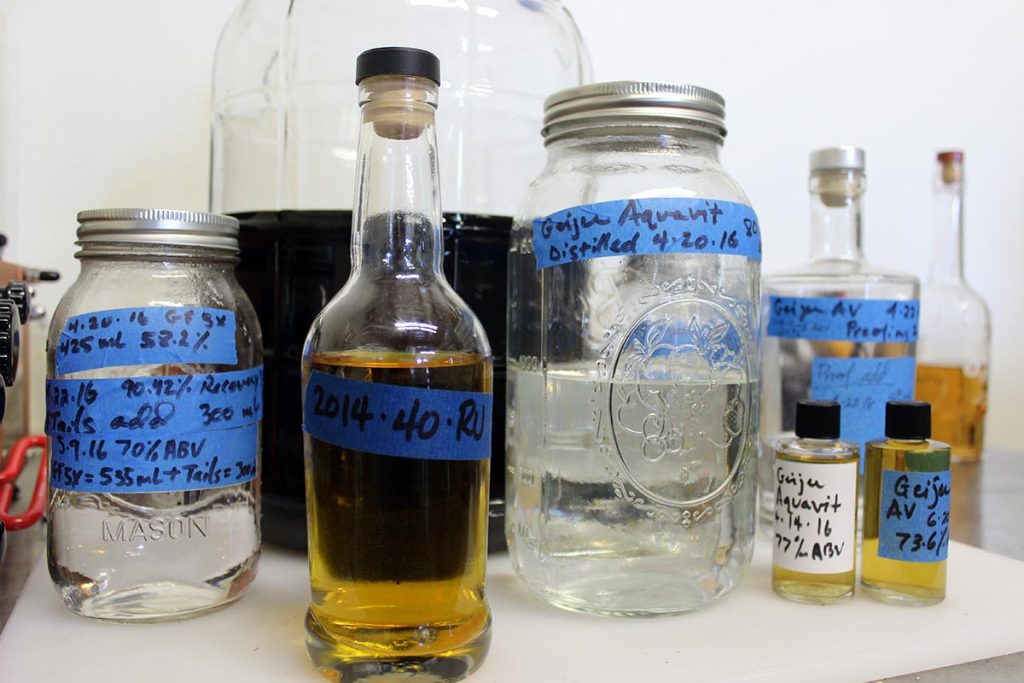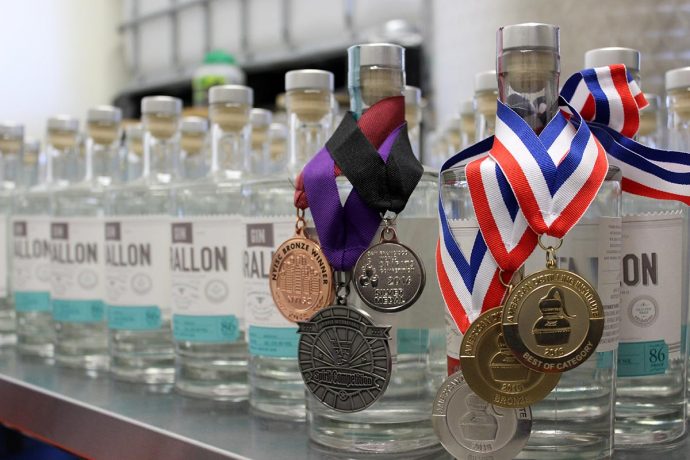As much fun as the end product may be, distilling spirits is a scientific pursuit at heart. Looking back on the organic chemistry classes I took in college (the trauma has since worn off a bit), much of what we did in the lab was reminiscent of what we see in craft distilleries all over the country: hours of exacting preparation, obsessive attention to detail, and, more often than not, a good deal of trial and error.
But for Brad Plummer, founder of Coastal Spirits in San Carlos, California, that’s all part of the fun. A self-described tinkerer at heart, Plummer has spent the last five years building a one-man distillery whose spirits—Gin Farallon and Vodka Farallon, so far—have beaten out world-renowned competitors for some of the most prestigious awards in the industry. All it took was a lot of time and a willingness to experiment.
“Slow Down, Forget the Plums”
Plummer got his start, as so many distillers do, by catching the homebrewing bug. “It’s fascinating to me,” he said as we sat in the office of his unassuming distillery, sipping on a handful of work-in-progress spirits and liqueurs. “You can take an organism, get it to colonize a certain food source, and out comes beer! It’s amazing.”
While running the media group at Stanford University’s physics laboratory (a job he got thanks to his graduate degree in science journalism), Plummer found himself dabbling in a number of scientific and artistic exploits. “I worked at the linear accelerator lab for eight years doing all kinds of things, and ended up becoming a photographer and filmmaker while I was there. Distilling is a bit of a departure, but there’s obviously a very scientific side to this kind of pursuit.”

Brad Plummer and his still
One day, a colleague of his came into the lab with a box full of plums so ripe that they were beginning to ferment on their own, and offered them to anyone who would take them off his hands. “I thought I could make some wine with them and maybe get some brandy out of it,” Plummer explained. “I didn’t have any idea how to do that, but I said I’d take ‘em. So I went into this little brewing shop in San Francisco, and I told them my situation and asked what I needed to turn the fruit into booze.”
Their response was, “Slow down, forget the plums, and read this book,” handing him a copy of the classic volume Making Pure Corn Whiskey, which Plummer still uses as a reference to this day. He read it cover-to-cover that weekend, and was officially hooked. “I did end up trying to make something from those plums anyway,” he admitted. “It was terrible.”
Undeterred, though, Plummer set his sights on the spirits business. “I love to tinker, I love making stuff. I’ve always been kind of a maker, a builder of things. I tell people this is the perfect confluence of my core interests, which are tinkering, gastronomy, and booze,” he chuckled. “I can make stuff with my hands, and it has to do with flavors and the building of flavors. And then, you know, it’s alcoholic! It’s a lot of fun for me.”
Learning to Think Small
Plummer and his wife, who had just had their first child, had long been interested in starting a family business. “We’d been talking for a while, wondering what was next for us, and we decided we wanted to start something of our own, run something, build something,” he recounted. “I had learned through my sort of tangential tinkering with beer and brandy that there was a big movement going on in the craft spirits industry. I’d visited a couple of small, local distilleries, and it seemed like it would be awesome.”
Thanks to the enthusiastic teachings of a Scottish friend, Plummer found himself gravitating towards whiskey and gin—the latter of which had long been one of his favorite spirits. Whiskey, though, proved to be a bit beyond his early abilities, necessitating difficult and time-consuming fermentation and aging.

The floor of the Coastal Spirits “nanodistillery”
“But it turns out gin is really hard to make,” he said, laughing. “You know, the levers that you turn to actually make the flavors change are so sensitive. A little bit of this versus a little bit of that, you get completely different results. So I just became fascinated with making gin because it was so hard for me.”
That’s where Plummer’s affinity for trial and error came into play. For him, the challenge of perfecting a gin was an exciting one. “I made about nine different recipes before I found one that was really what I wanted, and that’s the one we went on to develop here. Last year, we spent about six months scaling up that particular recipe. That’s Gin Farallon.”
The phrase “scaling up” tends to evoke images of expansive warehouses, rows of column stills, automatic bottling machines, and truckloads of booze. Not so for Coastal Spirits. Their San Carlos headquarters isn’t much bigger than a large single-car garage, yet it houses everything Plummer needs to produce his gin and vodka—an arrangement he has proudly termed a “nanodistillery.”
Striking Gold
Distilling is, for better or worse, a water-intensive process. Most spirits are more than half water by the time they make it to the liquor store shelf, primarily due to the dilution that brings their strength down to a potable proof. And, as Plummer learned, not all water is created equal.
“We live over on the coast, in Moss Beach. When I started getting into the brewing aspect of this business, I’d spent all this money on pH meters and learning how to adjust the quality of the water to work better with the yeast. Well, it turned out that the water coming straight out of the ground was perfect. It tasted great, and it made great beer. The limits were my own skill,” he laughed.
“So I contacted the water district there in Montara, and I got to know one of the supervisors of water quality. He came out and we talked, and when I started getting closer to developing Coastal Spirits I reached out to them again. We ended up partnering, and they gave me access to one of their aquifers. I drove a tank up a mountain and we filled it straight out of the ground. That’s the water we use to proof down our distillate for Vodka Farallon.”

An assortment of spirits still in development
While he can’t use it in his gin (the high mineral content doesn’t play well with the botanicals), Plummer is proud of that local touch—the vodka is smooth, understated, and boasts a hint of minerality as a result. “It turned out to be a really special recipe, at least in my estimation,” he said. “Something you can mix that can also stand on its own, something subtle. To me that’s really interesting.”
Gin Farallon is perhaps even closer to his heart. “I like the traditional London Dry style of gin, it’s what I drank heavily all through college and grad school,” he said with a laugh. “I like juniper, I like that character. And with regard to the current movement away from that juniper-forward style, you have a whole spectrum of gins, like Hendrick’s on one end—very light, very citrusy—and the London Dry style on the other. I kind of wanted the best of both worlds, so I worked on a recipe that fell somewhere in the middle. I’m really happy with the way it came out.”
The critics seem to agree. Since their launch, Plummer’s spirits have netted medals from the American Distilling Institute, the New York and Denver International Spirits Competitions, and most recently, the prestigious San Francisco World Spirits Competition.
Discovering What’s Next
Always the tinkerer, Plummer has had his eye on a number of new products since the early days of Coastal Spirits. While the business is still very much a solo project, he hopes to manage at least one new release per year for the foreseeable future. Nearest on the horizon is a line of craft liqueurs, several of which he’s still in the process of perfecting.
“I can take the cues and the advice from other people who are doing this, but you really have to discover your recipe,” he explained. “It’s not so much invention or copying. I could’ve made my process a lot simpler, I’m sure, but if you want something unique that has a character that you’re specifically going for, you kind of have to discover it yourself.”
And so, the experimentation continues. If the success Plummer has had with the Farallon line is any indication, those new discoveries promise to be quite unique indeed.
Photos: Will Shenton



